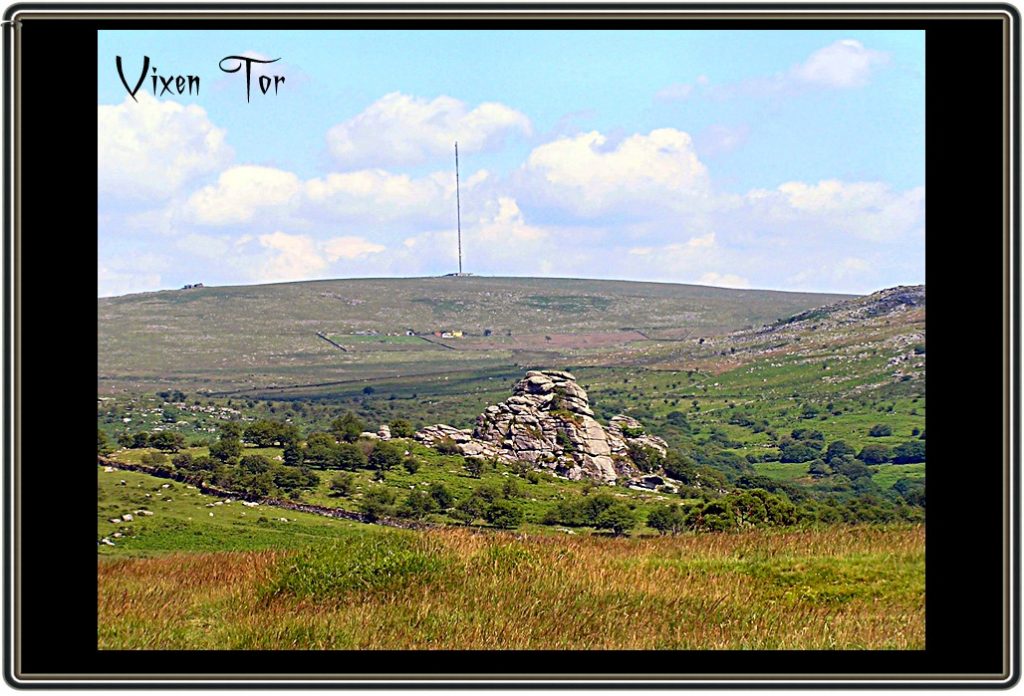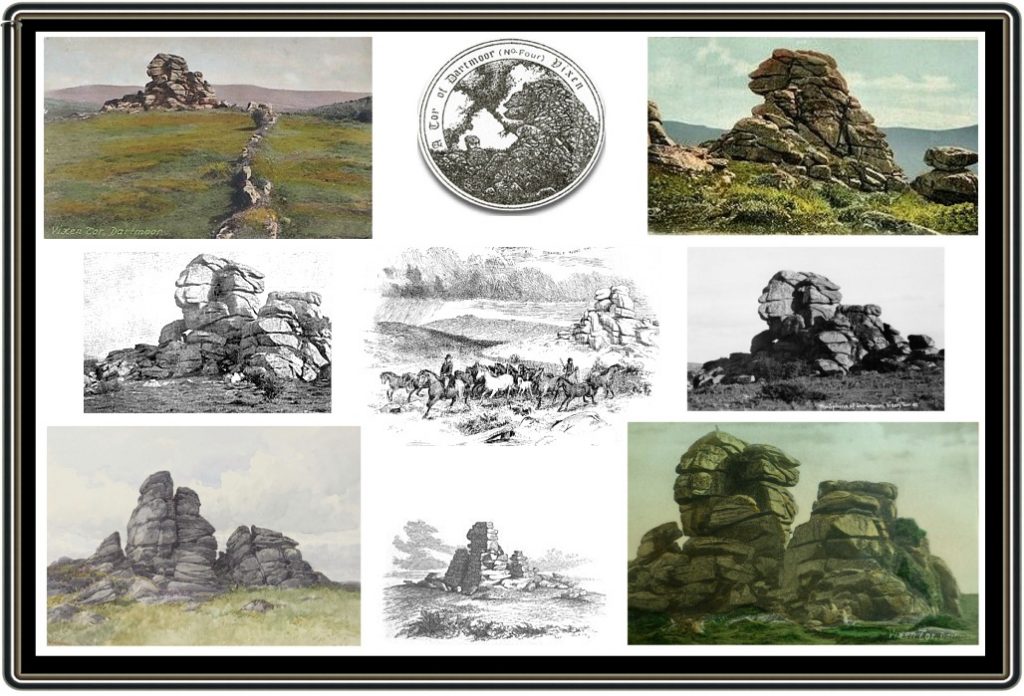

Vixen Tor has always been the focus for man’s attention, during the Bronze Age he buried his dead in the shadows of the mighty outcrop. Later on the tor entered the realms of Dartmoor legend as it played host to the evil witch Vixiana who lived amongst its dark caves. When people began visiting Dartmoor for recreational purposes Vixen Tor soon became a point of pilgrimage and a place to hold picnics. Today the tor has become the unwanted focus of a prolonged access dispute between the land owner and various opposing bodies. Sadly at the moment there is no public access to the venerable granite mass thus making it the ‘Forbidden Tor‘.
According to Terry Bound, (1991, p.90) Vixen Tor is the tallest tor on Dartmoor and is 30 metres high, which in old money is 98.425 feet. This measurement presumably has been made with the aid of modern surveying equipment. On the 3rd of October 1801 Mr Bray and his companion visited the tor with the aim of establishing its height:
‘Having only a ball of thin packthread, to which was affixed a small lead bullet, we attempted to throw it over, as, owing to a projection, we could not drop it; but the wind blew the thread out of its proper direction, and we were unsuccessful in two or three attempts; at last we wound the thread round the bullet and secured it better; but could not tell, though the thread was all expanded, whether it had reached the bottom. To satisfy ourselves as to this, though I stood in great need of the assistance of my companion, I resolved to get down by myself… On finding that the line did not reach the bottom, and that he had no more, I requested he would throw down the stick to which it was tied; but the wind carried it away, and on striking against the moss, the lead was not heavy enough to clear it Though vexed that our labour was partly in vain, I took a sketch of the rock with my friend on the top of it, to show we had ascended it. Whilst thus employed, he startled me by throwing down one of his boots, and afterwards the other, in order to have a firmer footing in his descent. On his way down he was so fortunate as to recover the string, and as I had marked how far it reached, I was in hopes, after all to know the elevation of the rock: as, in folding it over, he had entangled it, we had the greatest difficulty in unravelling it; and though two or three times we cut this Gordian knot, we were afraid our hopes would prove in vain. My vexation, which I confess was great, though about a thread, conduced not to mend the matter. However, by cutting, and tieing (sic), and making allowances for the entangled parts we found the height of the central rock to be about 110 feet.’, ( Bray, 1844, pp. 220 – 221).
After all that fuss and ado, these two men with the aid of some string and a bullet managed to estimate the height of Vixen Tor to within 12 feet of what has been established today by using expensive surveying gear. Having said that Vixen Tor is the tallest tor on Dartmoor it is by no means the highest as it sits at an elevation of about 317m (1,040ft), that distinction goes to High Willhays at a height of 621m. I recently came across a report in a local paper which stated the following;”The Plymouth Holiday Fellowship had a ramble on Dartmoor Saturday. They detrained at Horrabridge a walked via Plaister Down to Pew tor, where they had tea. They then went to Vixen Tor where one of the members climbed the tor and SIGNED THE BOOK after which they returned to Horrabridge.” – The Western Morning News, June 6th, 1934 . This is the only reference which alludes to a visitor’s book for the tor but presumably anyone who managed to scale the tor could sign the book, where it was kept I have no idea or what happened to it?
There is no indication of the place-name’s roots however it may be assumed that the ‘vixen’ element refers to the female fox who may have possibly made its home amongst the rocks of the tor. Due to the various morphology of it shape the tor has also been known as ‘The Sphinx’, ‘The Lion’s Head’ and more recently ‘The Forbidden Tor’. Most of the earliest topographical writers all refer to the Sphinx-like appearance of the tor which is presumably where the name came from as too did the lion’s head comparison.
Below are two early accounts dating from the early 1800s given by visitors to the tor.
‘The first object on the moor which we stop to examine is Vixen-Tor, a vast mass of rock rising like a sphinx in the desert on our right hand, at about a mile from the entrance of the moor. Vixen-Tor is to be approached in fine weather without difficulty; the bogs may be avoided by keeping near the fence, above Merrivale-Bridge. On approaching nearer, we discover that the sphinx has changed its form; the rock is now like a tower, with the ruins of a mighty cathedral strewn around. The tower is divided (it may be by the lightning’s flash); the summit of the pinnacles can only be gained by climbing up the division which is about the size of a large chimney. On the highest rock, two ravens have here from time immemorial, built their nest… We once attempted to go from Vixen-Tor to the opposite eminence (Feather Tor), and paid dearly for our pains, by meeting with some of the blackest, and most deceitful swamps, to be met with in any one spot. The disposition of some of the stones on Vixen-Tor, would give us leave to suppose that Druidical rites had here been performed. A projecting slab, resting on two upright supporters, has much the appearance of a cromlech.’, (Evans, 1846, pp. 134 – 135).
‘Vixen Tor presents itself to the eye from the road leading from Tavistock to Moreton in a picturesque and striking manner. Three contiguous lofty rocks raise themselves from the middle of the spacious plain, and, at different points of view, assume a vast variety of fantastic appearances. Sometimes you may fancy it bears resemblance to a lion’s head, at others to the bust of a man; and when seen from the Moreton road, it greatly resembles the Sphinx in the plains of Egypt, whilst the mountains beyond may give no bad idea of the pyramids around it… On the opposite side there is a perpendicular fissure, which we found large enough to admit us, and attempted to climb through it to the top of the loftiest pile; but the wind was so violent, and forced itself with such impetuosity up this narrow passage, that we at length gave up the attempt, but not till our eyes were filled with dust and moss…’, (Bray, 1844, p.213).
This first visit took place on the 17th of September 1801 and on the 3rd of October 1801 the resolute Mr Bray returned for a second attempt at gaining the summit of Vixen Tor:
‘We ascended the former on the north-east side through a fissure of about two feet in width, made by a division between two of the piles. We reached with difficulty (for it was like climbing up a chimney) the top of the lowest rock, where we sat for some time to rest ourselves. From this, with a wide stride, we got a footing on the other, and at length attained the summit.
The uppermost rock is divided into two or three masses, on parts of which we found moss and green turf, which, though damp with dew, afforded us a seat. Facing the east are three basins. One four feet long, three feet two inches wide, and eight inches deep. This has a lip at the edge. Of the two remaining basins, which communicate together, one is four feet in diameter and fourteen inches deep. The other is one foot and a half in diameter, and nine inches deep. They were the most regularly circular basins we had yet seen. And from these, also a lip discharged the water over the edge of the rock‘, (Bray, 1844, p.220).
The fashion of the early 1800s was for the antiquarians to attribute various natural and man-made prehistoric features to the work and use of the Druids. Mr Bray was a great exponent of this theory and therefore considered that the above rock basins and other natural rock formations on Vixen Tor had at one time been used in Druidical rites. He also mentions that during his second visit he left a twopenny piece in one of the basins for the next successful climber to find, (p.222), who knows it still may be there? Incidentally, Bray also mentions having seen the ravens nesting on Vixen Tor so they must have been a common sight. In the July of 1930 there was an outcry because somebody had destroyed a ravens nest on the tor. This act prompted calls for a public subscription so than a reward could be offered for any information as to who was the perpetrator.
It was mentioned above that prehistoric man viewed Vixen Tor with a certain amount of awe and used it to bury their dead in the shadows of its granite bastions. Today evidence of this rite can be seen in the form of a kistvaen which lies 100m to the north of the tor. This kist still display the four granite slide-slabs which project up from the ground, it measures 1.2m long and 0.7m wide and is thought to have had two covering slab, which are possibly the ones visible today. Originally the kist would have been covered by a cairn but the majority of the stones have been removed leaving just traces of the banking, (Hemery, 1983 p.1009/ Butler, 1994, p.33).
It is rather ironic that today there is no public access to Vixen Tor because the landowner claims that they do not want to be held liable for people having an accident when doing exactly what Mr Bray writes about some 207 years previously. Since his first recorded ascent of the tor many people have re-enacted his adventure, so much so that in 1995 there were 24 named climbing routes up the tor. These range in height from 30 – 160ft (although I am not sure how you climb 160ft up a 98ft tor?) and each one has its individual and sometimes foreboding names; Torture (60ft), Two Way Stretch (60ft), Sly (60ft), Angel of Mercy (60ft), Crunchy Toad (60ft) Plektron (60ft), Radjel (50ft), Solus (45ft), Boris Yeltsin (40ft), Old Men (45ft), Vendetta (65ft), Vixiana (40ft), The Fox (30ft), Bronco Dilator (30ft), Commando Crack (90ft), Eureka (90ft), Docker’s Dilemma (110ft), Enigma (90ft), Feasibility Study (120ft), Green Beret (100ft), Thrutch (160ft), Babylon (100ft), Monkey Business (25ft) and Down the Welly (25ft), (White, 1995, pp. 267 -272).
Being such a distinguishable landmark, Vixen Tor was at one time a popular area and subject for Dartmoor letterboxers. Numbers stamps (See Eric Spicer’s stamp above) have been designed with a distinct bias towards Vixiana the Witch. The tor was the site for one of the earlier of the letterboxes when the hobby first started, again, this is another activity that has been halted due to the access issue. Talking of Vixiana, it was she who guaranteed Vixen Tor a place in the folklore of Dartmoor. Very briefly she was a witch who lived on the tor and who lured travellers to a grizzly death in the bogs which lie under the granite outcrops. The full story of he evil doings and eventual downfall can be found on my Vixiana webpage – HERE.
Interestingly enough, Hemery, (1983, p.1008) relates how a lady did in fact once live in a little ‘homestead’ beneath the tor, he also notes how she told him that, ‘many, many years ago’ there was a custom of holding some kind of summer celebrations below the tor, sadly he does not expound on this any further. Crossing (1990, p. 148) however, informs us that this was Vixen Tor Farm and further adds, ‘As it (Vixen Tor) is situated within the farm enclosures, it will be better that we pass up by the house and obtain permission to visit it‘. The watercolour below was painted in 1900 and the small ‘homestead’ can clearly be seen sheltering under the mass of Vixen Tor. This is further substantiated by the following; “To the south of Merrivale Bridge is Vixen Tor, which from the road to Tavistock has the appearance of an Egyptian sphinx. From the tor there is a fine view in the distance of the valley of the Walkham. Tea is provided by a cottager who resides under the tor at a small charge.” – The United Devon Association, p. 115. In 1932 the Western Morning News carried the following extract from a letter; “Vixen Tor is the private property of Mr. Parsons, who lives in a house at the foot of the Tor. It has been owned by his family for 200 years. He kindly allows people to visit the tor. Of late years so much trouble has been given by thoughtless persons strewing the ground around with paper and broken bottles that closing the tor to visitors and picnics parties has been under consideration.” – July 12th, p.4.

Vixen Tor has also received mention in several literary works, the most famous of which must be Conan Doyle’s, Hound of the Baskervilles, additionally it featured in Eden Phillpotts’ novel ‘The Mother’ where he penned the following description: ‘Like a child in a mother’s arms the little homestead of the Pomeroys reposed on the southward slope of the Vixen and cuddled there beneath the immense rock-masses of that tor. No nobler pile of granite shall be found upon Dartmoor. It towers gradually to its crown rampart and bastion; a happy relation of parts has chanced to weld the three main divisions into one perfect whole, and Vixen rises, the very impersonation of strength, solidity and settled purpose, to be a landmark for time, the haunt of nocturnal birds, an emblem of mystery and power‘, (Day, 1981, p.132). The ‘little homestead’ Phillpotts refers to must have been inspired by the same ‘homestead’ Crossing writes about, namely Vixen Tor Farm.
There would be little point of visiting the landowner today in order to gain permission for access, as noted above Vixen Tor is strictly private and off limits. The dispute has been going on since 2003 and still shows no signs of being resolved despite threats, mass trespasses, websites and unfavourable press. Being no expert in access law, there is one question that comes to mind – if you look the 1907 OS six-inch map you will clearly see that a footpath is marked running through the enclosures and around the tor. So, until this dispute is finally resolved everyone will have to be content with staring at Vixen Tor from behind the enclosure wall as if it were an animal in a zoo. Unless of course you fancy climbing the wall and partaking in a spot of trespass?

Bray, E. 1844. Legends, Superstitions and Sketches of that part of Devonshire on the Borders the Tamar. London: Murray.
Butler, J. 1994. Dartmoor Atlas of Antiquities – Volume III. Exeter: Devon Books.
Crossing, W. 1990. Crossing’s Guide to Dartmoor. Newton Abbot: Peninsula Press.
Day, K. 1981. Eden Phillpotts on Dartmoor. Newton Abbot: David & Charles.
Evans, R. 1846. Home Scenes or Tavistock and its Vicinity. London: Simpkin and Marshall.
Hemery, E. 1983. High Dartmoor. London: Hale Publishing.
United Devon Association. 191900. A Book of Fair Devon. Exeter.
White, N. 1995. South Devon and Dartmoor – A Climbers’ Guide. Leicester: CORDEE.
 Legendary Dartmoor The many aspects past and present of Dartmoor
Legendary Dartmoor The many aspects past and present of Dartmoor




hi i have a amazing water color by charles e. britten of vixen tor this site has been great to find out about vixen tor thank you
regards
Mark Kinghan
New Zealand